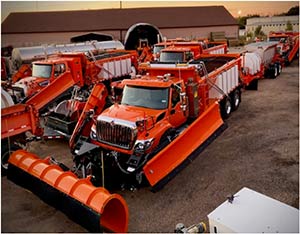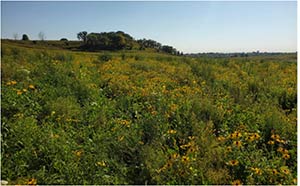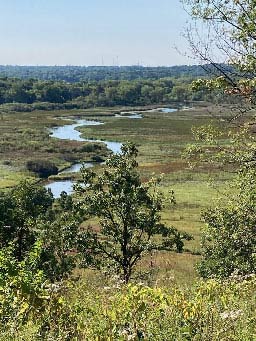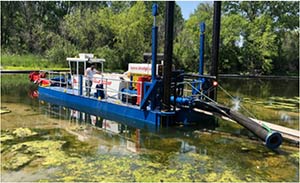
 The flooding, fires, and extreme temperatures gripping the globe year after year offer irrefutable, tangible evidence we are in the midst of a climate crisis. June and July of this summer went into the books as the hottest months on record globally. The wide swings of extremes and unpredictability are self-evident of a climate that's changing. For much of this summer our area was about one foot below normal for precipitation. The U.S. Drought Monitor lists Dane County as being in a moderate drought and reports this May to July was the 13th driest on record for the Upper Midwest Climate Region. Just next door, the State of Minnesota saw its second driest summer in the history of weather record keeping which has impacted fish populations, crops, and even sparked fires near the beautiful Boundary Waters. A recent analysis found extreme weather cost U.S. taxpayers $99 billion in the past year. An August report from the United Nations Intergovernmental Panel on Climate Change, penned by 234 scientists, projects repetitive severe weather occurrences over the coming decades. We are living the evidence of a worsening climate crisis. The time for profound, substantive change - is now.
The flooding, fires, and extreme temperatures gripping the globe year after year offer irrefutable, tangible evidence we are in the midst of a climate crisis. June and July of this summer went into the books as the hottest months on record globally. The wide swings of extremes and unpredictability are self-evident of a climate that's changing. For much of this summer our area was about one foot below normal for precipitation. The U.S. Drought Monitor lists Dane County as being in a moderate drought and reports this May to July was the 13th driest on record for the Upper Midwest Climate Region. Just next door, the State of Minnesota saw its second driest summer in the history of weather record keeping which has impacted fish populations, crops, and even sparked fires near the beautiful Boundary Waters. A recent analysis found extreme weather cost U.S. taxpayers $99 billion in the past year. An August report from the United Nations Intergovernmental Panel on Climate Change, penned by 234 scientists, projects repetitive severe weather occurrences over the coming decades. We are living the evidence of a worsening climate crisis. The time for profound, substantive change - is now.
While we as a county government cannot solely course correct the trajectory of this emergency, we continue to be a bold, progressive, leading voice at what is possible for the public and private sectors to help alter what is otherwise a disturbing destiny. We are reducing emissions, increasing renewable energy generation and capitalizing financially on acting in the best interest of the planet we inhabit. Our leadership on this was recently recognized by the U.S. Environmental Protection Agency which named Dane County one of its five 2021 “Green Power Leaders.” We were the only public sector entity honored alongside Microsoft, Starbucks, the University of California, and Boston University.
 Our Dane County Renewable Natural Gas (RNG) plant is on track for a record year producing clean burning fuel and revenue by converting methane gas from the landfill into compressed renewable natural gas for vehicle fuel. The facility is projected to displace 4,750,000 gallons of gasoline this year, reducing emissions equivalent to traveling 106-million less miles on the roads or sequestering carbon from planting 700,000 trees. Thanks to the courage of our innovation, that’s what we are accomplishing in just one year of operation.
Our Dane County Renewable Natural Gas (RNG) plant is on track for a record year producing clean burning fuel and revenue by converting methane gas from the landfill into compressed renewable natural gas for vehicle fuel. The facility is projected to displace 4,750,000 gallons of gasoline this year, reducing emissions equivalent to traveling 106-million less miles on the roads or sequestering carbon from planting 700,000 trees. Thanks to the courage of our innovation, that’s what we are accomplishing in just one year of operation.
The RNG drop-off station at our facility brought in more semi-trucks of compressed gas from dairy digesters, like the project Dane County started several years ago near Waunakee. The second, other dairy digester we partnered on outside of Middleton is rapidly converting operations to truck gas to our county gas plant as well. This facility is under new ownership as Wisconsin based EnTech Solutions and Northern Biogas are expected to have their gas production online by January 1st. The county constructing this gas unloading station at our landfill has completely remade the work we started a decade ago to improve water quality and reduce manure run-off. The economics of digesters now make more sense and in the coming years we will see more Dane County dairies bringing their manure to the digesters we helped construct. Capturing and converting these renewable fuel sources is not only good for our lakes but it also significantly reduces carbon emissions and earns county taxpayers millions of dollars.
 The clean fuel injected into the pipeline at our landfill powers trucks and vehicles across the region – including our own county fleet - reducing diesel and carbon emissions. In fact, since we launched our compressed natural gas (CNG) initiative years ago, almost half of our fleet of 60 highway snowplows -literally dozens of heavy trucks - are now powered by CNG. Across all of county government we now have 100 CNG vehicles and 17 that are electric hybrids. My budget expands that initiative with over $5 million for the purchase of CNG trailers to help fuel up our highway fleet in areas of the county where compressed natural gas filling stations are less available. Additionally, I’m including nearly $2 million for installation of a new CNG filling station at the Fish Hatchery Road Highway garage and $3.2 million for the purchase of 8 more CNG powered snowplows. All told, this more than $10 million investment in clean fuel infrastructure further reduces our reliance on diesel and expands the reach of renewables into more rural parts of the county. This will make our fleet of plows more efficient both in their energy consumption and reduced time needed for refueling.
The clean fuel injected into the pipeline at our landfill powers trucks and vehicles across the region – including our own county fleet - reducing diesel and carbon emissions. In fact, since we launched our compressed natural gas (CNG) initiative years ago, almost half of our fleet of 60 highway snowplows -literally dozens of heavy trucks - are now powered by CNG. Across all of county government we now have 100 CNG vehicles and 17 that are electric hybrids. My budget expands that initiative with over $5 million for the purchase of CNG trailers to help fuel up our highway fleet in areas of the county where compressed natural gas filling stations are less available. Additionally, I’m including nearly $2 million for installation of a new CNG filling station at the Fish Hatchery Road Highway garage and $3.2 million for the purchase of 8 more CNG powered snowplows. All told, this more than $10 million investment in clean fuel infrastructure further reduces our reliance on diesel and expands the reach of renewables into more rural parts of the county. This will make our fleet of plows more efficient both in their energy consumption and reduced time needed for refueling.
As we amass our renewable energy credit portfolio it’s critical we monitor our efforts in real time to maximize both the environmental and economic benefits of the investments we make. My budget creates a new Renewables Finance Officer position in the Department of Waste and Renewables to compile and manage the data that corresponds with this innovative work. We have led the way and paved the road to energy independence for units of government and private industry.
 A little over a year from now Dane County will be on the cusp of being the first public entity of its size in the region to generate more renewable electricity than we use. Through a partnership with Alliant Energy and Wisconsin-based SunVest Solar, construction is slated to begin early next year on a more than 100 acre solar farm on county land near our Renewable Natural Gas production facility off Highway 12. This project when complete will generate over 17 megawatts of electricity, enough energy to power 3,100 homes per year. Perhaps more importantly, this installation combined with the county's solar partnership with MGE at the Dane County Regional Airport, along with close to 20 solar developments at county facilities, will result in us producing more renewable energy than the total amount of electricity we consume for our operations. In less than nine months, our solar project at the Airport generated enough carbon free electricity (12 million kilowatt hours) to power 1,200 Wisconsin homes for an entire year. County government will be 100% sustainable in a matter of months. If we want to move the dial on the climate crisis this kind of work can’t wait decades or it will prove too little, too late. We all have a responsibility to act now and that’s just what Dane County government is doing. That’s why I’m also including $300,000 in this budget for an updated energy efficiency audit of all county facilities. This work was last done a number of years ago and provided a framework for many of the initiatives now in place. Revisiting this for a progress report is integral to us remaining on the cutting edge of efficiency, leading by example, and doing all we can for the immense challenge at hand.
A little over a year from now Dane County will be on the cusp of being the first public entity of its size in the region to generate more renewable electricity than we use. Through a partnership with Alliant Energy and Wisconsin-based SunVest Solar, construction is slated to begin early next year on a more than 100 acre solar farm on county land near our Renewable Natural Gas production facility off Highway 12. This project when complete will generate over 17 megawatts of electricity, enough energy to power 3,100 homes per year. Perhaps more importantly, this installation combined with the county's solar partnership with MGE at the Dane County Regional Airport, along with close to 20 solar developments at county facilities, will result in us producing more renewable energy than the total amount of electricity we consume for our operations. In less than nine months, our solar project at the Airport generated enough carbon free electricity (12 million kilowatt hours) to power 1,200 Wisconsin homes for an entire year. County government will be 100% sustainable in a matter of months. If we want to move the dial on the climate crisis this kind of work can’t wait decades or it will prove too little, too late. We all have a responsibility to act now and that’s just what Dane County government is doing. That’s why I’m also including $300,000 in this budget for an updated energy efficiency audit of all county facilities. This work was last done a number of years ago and provided a framework for many of the initiatives now in place. Revisiting this for a progress report is integral to us remaining on the cutting edge of efficiency, leading by example, and doing all we can for the immense challenge at hand.
 We know how we use and care for the land has an impact on carbon emissions. A couple of years ago I launched the Dane County Continuous Cover program, a first of its kind effort to help maintain the rural character and landscape of our fast growing county that helps reduce runoff and erosion, keep farmers and growers on the land, and yes, helps trap carbon. The program is quite simple. Interested landowners voluntarily enter into long term agreements with the county to be paid for converting lands into grasses and prairies. I'm pleased to report Dane County Continuous Cover has been a resounding success. 2021 was the third year of this program that to date has helped protect 1,600 acres across the county. I started this effort with $750,000 in 2019. I doubled it the year after and in this budget I'm increasing funding to $2.5 million to help us convert and conserve more lands. To date, 40% of the lands in the program are used for grazing, 30% are in a cool season grass mix, and 30% have been converted to native prairie for pollinators and wildlife habitat. Interest in Continuous Cover remains high and I'm confident these additional dollars will help us move quicker on accomplishing our shared goals of reducing the risk of flooding and trapping more carbon.
We know how we use and care for the land has an impact on carbon emissions. A couple of years ago I launched the Dane County Continuous Cover program, a first of its kind effort to help maintain the rural character and landscape of our fast growing county that helps reduce runoff and erosion, keep farmers and growers on the land, and yes, helps trap carbon. The program is quite simple. Interested landowners voluntarily enter into long term agreements with the county to be paid for converting lands into grasses and prairies. I'm pleased to report Dane County Continuous Cover has been a resounding success. 2021 was the third year of this program that to date has helped protect 1,600 acres across the county. I started this effort with $750,000 in 2019. I doubled it the year after and in this budget I'm increasing funding to $2.5 million to help us convert and conserve more lands. To date, 40% of the lands in the program are used for grazing, 30% are in a cool season grass mix, and 30% have been converted to native prairie for pollinators and wildlife habitat. Interest in Continuous Cover remains high and I'm confident these additional dollars will help us move quicker on accomplishing our shared goals of reducing the risk of flooding and trapping more carbon.
Our Conservation and Lake Preservation and Renewal funds have protected thousands of acres over the past decade. They're also critical to us becoming a net carbon neutral community. This benefit is exacerbated in areas we preserve where development may have otherwise occurred. The path we took to being 100% renewable with our energy consumption is the blueprint for us to achieve carbon neutrality. Our conservation efforts will be integral to this next achievement, which I believe can be accomplished by 2030 or sooner. That's why I'm creating a new position in the Department of Land and Water Resources to help compile all of county government's carbon reduction accomplishments. This scientist will lead development of a restoration plan that prioritizes initiatives the help us clean both water and air, directly countering climate change. I’m also creating a new Environmental Engineer position in the Department of Land and Water that will help design and oversee these conservation projects.
 The County’s 2019 investment in a 160-acre addition at the Pheasant Branch Conservancy is a good demonstration of how our Conservation Fund is the perfect vehicle to develop a carbon offset program and enhance water quality. Following the purchase, the County took on the duty of restoring the wetland function of the property, improving flood control and water quality. We are now partnering with the Friends of Pheasant Branch and the Clean Lakes Alliance to restore the surrounding uplands to an exceptionally diverse native prairie. Together, these projects will prevent 2.6 million gallons of rainwater and 500 pounds of phosphorus from running directly into Lake Mendota each year, while also giving the public a beautiful destination for hiking and other outdoor activities. I'm increasing funding for Dane County's Conservation Fund by an additional $1 million, bringing the total to $6 million available for land preservation work in 2022. Our continued leadership on conservation will pay dividends far beyond this generation for quality of life, water quality, flood mitigation, and yes, the pollinators and other species impacted by the fast changing world they call home.
The County’s 2019 investment in a 160-acre addition at the Pheasant Branch Conservancy is a good demonstration of how our Conservation Fund is the perfect vehicle to develop a carbon offset program and enhance water quality. Following the purchase, the County took on the duty of restoring the wetland function of the property, improving flood control and water quality. We are now partnering with the Friends of Pheasant Branch and the Clean Lakes Alliance to restore the surrounding uplands to an exceptionally diverse native prairie. Together, these projects will prevent 2.6 million gallons of rainwater and 500 pounds of phosphorus from running directly into Lake Mendota each year, while also giving the public a beautiful destination for hiking and other outdoor activities. I'm increasing funding for Dane County's Conservation Fund by an additional $1 million, bringing the total to $6 million available for land preservation work in 2022. Our continued leadership on conservation will pay dividends far beyond this generation for quality of life, water quality, flood mitigation, and yes, the pollinators and other species impacted by the fast changing world they call home.
 The Dane County Office on Energy Climate Change completed our Climate Action Plan a year ago, our community’s blueprint to getting the work done that’s needed for the health of our planet. As the Office pivots toward implementation of practices beyond county government, I’m including just over $93,000 in the budget to jumpstart creation of a Civilian Climate Corps. Modeled after our highly successful Dane County Conservation Crews, Operation Fresh Start will use these start-up funds to build partnerships and develop a team of young people dedicated to working on energy efficiency projects. This may include winterizing buildings or helping to make other modifications to reduce carbon emissions or increase renewable energy consumption. By launching this work now, Operation Fresh Start will be well positioned to become part of the new proposed federal Climate Corps, a 10 year, $10 billion initiative to tackle climate change.
The Dane County Office on Energy Climate Change completed our Climate Action Plan a year ago, our community’s blueprint to getting the work done that’s needed for the health of our planet. As the Office pivots toward implementation of practices beyond county government, I’m including just over $93,000 in the budget to jumpstart creation of a Civilian Climate Corps. Modeled after our highly successful Dane County Conservation Crews, Operation Fresh Start will use these start-up funds to build partnerships and develop a team of young people dedicated to working on energy efficiency projects. This may include winterizing buildings or helping to make other modifications to reduce carbon emissions or increase renewable energy consumption. By launching this work now, Operation Fresh Start will be well positioned to become part of the new proposed federal Climate Corps, a 10 year, $10 billion initiative to tackle climate change.
 Our leadership to mitigate what’s so adversely impacting our planet is second to none. So too are our adaptation strategies. "Suck the Muck" has another full year of work ahead removing phosphorus soaked sludge sitting in Six Mile Creek not far from Lake Mendota. Research by our county staff discovered that legacy phosphorus concentrations in the stream bed sediments flowing into the Yahara Lakes are seven times greater than nearby crop fields. These phosphorus concentrations are delivered to our lakes, fueling algae blooms that cause beach closings and the unsightly smells and sights to those who recreate in, on, and around our lakes. To date we have extracted 31,000 tons of sediment (about 2,500 dump truck loads) containing over 100,000 pounds of phosphorus from Dorn and Token Creeks. The next phase of sediment removal from Six Mile Creek, located in the Town of Westport, is expected to begin in the fall of 2021 with dredging to start in the spring of 2022. I’m putting an additional $500,000 in the budget for “Suck the Muck” next year bringing the total invested on this water quality project to $12 million since 2017.
Our leadership to mitigate what’s so adversely impacting our planet is second to none. So too are our adaptation strategies. "Suck the Muck" has another full year of work ahead removing phosphorus soaked sludge sitting in Six Mile Creek not far from Lake Mendota. Research by our county staff discovered that legacy phosphorus concentrations in the stream bed sediments flowing into the Yahara Lakes are seven times greater than nearby crop fields. These phosphorus concentrations are delivered to our lakes, fueling algae blooms that cause beach closings and the unsightly smells and sights to those who recreate in, on, and around our lakes. To date we have extracted 31,000 tons of sediment (about 2,500 dump truck loads) containing over 100,000 pounds of phosphorus from Dorn and Token Creeks. The next phase of sediment removal from Six Mile Creek, located in the Town of Westport, is expected to begin in the fall of 2021 with dredging to start in the spring of 2022. I’m putting an additional $500,000 in the budget for “Suck the Muck” next year bringing the total invested on this water quality project to $12 million since 2017.
The third phase of our flood dredging efforts will move to the southern sections of the Yahara River in 2022 once work now underway between Lake Waubesa and Lower Mud Lake is completed. With countless flash flood warnings, mudslides, and deluges in other parts of Wisconsin this summer, the reminders of what climate changed induced storms can do - like 2018's devastation here in Dane County - lurks nearby. We know in an era of extremes these inundating rains are not a fear of the 22 future, they’re happening on a regular basis already. The only question is when this will occur again in our county. Any of the work we can get done in advance of that next flood will help limit future loss in our community and bolster our climate resiliency. My budget has $3 million for the next phase of flood risk reduction dredging in the Yahara River from Lake Kegonsa to County Highway B. This work is seeing success. Dredging between Lakes Monona and Waubesa in 2020 removed 40,000 cubic yards of sediment, deepening the Yahara River by as much as four feet. Next year’s phase is projected to start in spring and will remove an estimated 65,000 of run-off from the river bottom. County government has committed $13.5 million to flood prevention dredging since 2019. We will be better prepared for the next round of record rains and more importantly, our communities will be safer.
 My budget includes a couple of other notable water quality initiatives. I’m expanding the county’s lake weed harvesting program, adding the equipment and staff to make it operational 10 hours a day, 5 days a week during summers. Currently our cutters work 8 hours a day. The budget includes $225,000 for a new aquatic plant harvesting machine, $35,000 to staff it, and a full-time mechanic to support the work of our expanding weed harvesting and dredging fleet. Additionally, I’m expanding the county’s multi-year partnership with the City of Madison to develop Clean Beach Corridors to promote safer swimming for children and families. The county first developed these systems at Lake Mendota and Goodland County Parks and they’ve proven incredibly popular family destinations for fun in recent summers. This year we partnered with Madison to build one at Warner Park that will mark its grand opening around next Memorial Day. This budget includes $85,000 next year for our next shared City-County Clean Beach Corridor, slated for Tenney Park Beach.
My budget includes a couple of other notable water quality initiatives. I’m expanding the county’s lake weed harvesting program, adding the equipment and staff to make it operational 10 hours a day, 5 days a week during summers. Currently our cutters work 8 hours a day. The budget includes $225,000 for a new aquatic plant harvesting machine, $35,000 to staff it, and a full-time mechanic to support the work of our expanding weed harvesting and dredging fleet. Additionally, I’m expanding the county’s multi-year partnership with the City of Madison to develop Clean Beach Corridors to promote safer swimming for children and families. The county first developed these systems at Lake Mendota and Goodland County Parks and they’ve proven incredibly popular family destinations for fun in recent summers. This year we partnered with Madison to build one at Warner Park that will mark its grand opening around next Memorial Day. This budget includes $85,000 next year for our next shared City-County Clean Beach Corridor, slated for Tenney Park Beach.